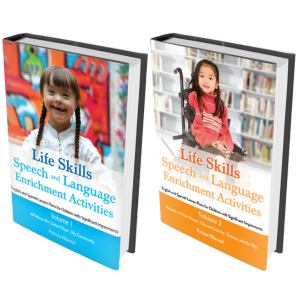Freaked out about feeding difficulties? Here’s some food for thought:

Here are some Feeding Difficulty Facts…
FACT: In the U.S., over 40,000 infants are born extremely pre-term (less than 28 weeks)
FACT: Over 50% of former pre-term babies present with feeding difficulty in infancy and toddlerhood that result solely from being pre-term
FACT: Some studies have shown reflux in up to 100% of preterm infants and 90% of term infants, resulting in the need for feeding therapy.
FACT: Reflux is one cause of a feeding aversion.
FACT: Some toddler- and school-age children refuse food due to pain, difficulty eating, and anxiety.
FACT: Qualified professionals provide feeding therapy to help babies and children receive adequate nutrition and thrive.
Looking for information in Spanish? Click here: Información Sobre la Alimentación de los Niños Pequeños
 I have a confession to make. I HAVE felt freaked out about feeding! Why you ask? Here are MY facts!
I have a confession to make. I HAVE felt freaked out about feeding! Why you ask? Here are MY facts!
FACT: Feeding wasn’t a course that was offered during my graduate school experience.
FACT: Dysphagia can lead to pneumonia and I definitely don’t want to be responsible for that!
FACT: I have beaucoup knowledge to learn about feeding therapy and evaluations.
However, here’s another fact. Through seminars and continuing education I HAVE made gains in my feeding knowledge that I would like to share with you to HELP you with this area. And all of this applies to feeding therapy for even the pickiest of eaters.
The Critical Oral Motor Milestones for Feeding
0-1 months of age
- coordination of suck-swallow-breath pattern
- establish stable neurophysiological regulation, including feeding and eliminating
- liquids only
1½-3 ½ months of age
- steady head control
- parents provide nutrition and child drives amount of intake
4-6 months of age
- anatomical changes- downward/forward growth of mandible, larger oral space, tongue no longer fills oral cavity, laryngeal space widens, muscle function takes over previously protective anatomy
- reflexive sucking is replaced by learned/volitional motor response (active sucking)
- anterior –posterior movement achieved with active movement forward and backward versus pressure changes
- beginning hand to mouth play
- begin pureed solids

WATCH FOR: Child’s anterior/posterior tongue movement
6-7 months of age
- trunk control sufficient for independent sitting for greater than 3 minutes
- stable head control in sitting
- establish mutually contingent feeding interactions-parent follows the baby’s cues
- begin meltable solids (rice crackers, Baby mum mums, cheese puffs or other puffed foods, Town crackers; We don’t want anything too small! The food should easily dissolve
7-9 months of age
- emerging tongue lateralization
- munching/vertical jaw movements develop
- lip closure supports anterior-posterior movement of food
- begin soft foods in cube form (ripe pear without skin, avocado) The goal is that the food will become mashed quickly; the child should be able to swallow with 1 swallow

WATCH FOR : Refusal between 6-12 months if child does not have sensory experiences with new textures
12-14 months of age
- active tongue lateralization
- rotary chew emerges
- change in taste bud perception
- child begins to assert self as separate individual and may refuse previously accepted foods
- begin soft regular solids and mixed textures

WATCH FOR: If tongue lateralization is absent, child may not feel safe creating bolus and moving it posteriorly in the oral cavity.

WATCH FOR: Is child asserting him/herself and refusing food?

Straw drinking can be introduced at this time.
14-16 months of age
- efficient finger feeding
- practicing utensil use
- begin harder to chew solids
18-24 months of age
- mature rotary chewing pattern
- able to eat regular table food diet

If child is gagging or has other feeding difficulties, an oral problem may be present because the food ‘level’ is too high.
Signs and Symptoms of Feeding Difficulties
- Failure to thrive with poor weight gain, weight loss or difficulty maintaining weight
- Choking, gagging, coughing or vomiting during meals
- Report of overstuffing the mouth with food and fear of choking
- Vomiting, reflux, crying/arching with feeding or other identified GI issues
- History of eating and breathing coordination problems with ongoing feeding concerns
- Children with oral feeding skills at risk for G-tube placement, with G-tubes or transitioning off tube feeding
- Refusal of bottle/breast feeding, especially with report of better results with sleep feeding (sleep feeding may occur due to child not feeling good while feeding/reflux)
- Inability to transition to baby food purees WHY? May be hyposensitive and need meltables or home prepared purees
- Inability to transition to table food solids or wean off baby purees
- Inability to transition to table food solids or wean off baby purees
- Inability to transition from breast/bottle to a cup
- Aversion or avoidance of a wide repertoire of tastes, temperatures and textures of foods
- Ongoing report of decreased appetite and limited intake with growth and/or nutrition concerns
- Food range of less than 20 food with concerns and/or other rigid feeding behavior
- Family distress over food and feeding; feeding time is stressful or meals are ‘battles’
Still experiencing feeding difficulties? Here are two comprehensive websites/resources to support you during the learning process.
ASHA Information about Feeding




Tengo un Centro de beneficencia para niños con problemas de aprendizaje en Linares N. L. (cerca de Monterrey) y me interesa mucho todos sus artículos que publican y su material para apoyo de los niños.
Hola Señora Guadalupe,
Estoy tan feliz que usted está usando los materiales que estamos publicando. Favor de contactarnos para cualquier ayuda que se necesite para el centro. ¡Están haciendo un trabajo muy importante enseñando los niños!
engo un guardería y centro de rehabilitación en Monterrey mi página esta aqui.
Me gusta e intensa sus materiales favor de comunicarse !!,
Dra Odet muciño milano
Glad that this information is useful. We are translating a page on feeding help into Spanish. It should be published soon.
Contento de que esta información es útil. Estamos traduciendo una página sobre ayuda con la alimentación a español. Debe ser publicada pronto.
We added information on feeding in Spanish:
Agregamos más información en español. Haga clic en el enlace: Información Sobre la Alimentación de los Niños Pequeños
You did not address the importance of open cup drinking at 8-9 months to get lip closure, jaw stability, and correct tongue positioning before straw drinking. If you present the straw too soon they will suckle the straw like the bottle precipitating the front to back tip down positioning rather than the ability to collect the bolus. It is also very important to stay away from all spout cups. Use the 360 flat top no spill cups. Avent for 8 months to 12 or 14 months then the WOW, Munchin, or Sassy.
I do Early Intervention and we are seeing way too many mouth issues as a result of poor oral development due to spout, incorrect/prolonged use of pacific er, incorrect straw drinking, open mouthed posture, prolonged drooling, mouth breathing and severe clarity issues.
This is really good advice. Thanks for the addition!